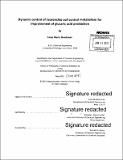Dynamic control of Escherichia coli central metabolism for improvement of glucaric acid production
Author(s)
Brockman, Irene Marie
DownloadFull printable version (17.34Mb)
Other Contributors
Massachusetts Institute of Technology. Department of Chemical Engineering.
Advisor
Kristala L. Jones Prather.
Terms of use
Metadata
Show full item recordAbstract
Metabolic engineering strategies have enabled improvements in yield and titer for a variety of valuable small molecules produced in microorganisms. Past approaches have been focused on up- and downregulation of genes to redistribute steady-state pathway fluxes, but more recently strategies have been developed for dynamic regulation. Dynamic gene expression profiles allow trade-offs between growth and production to be better managed and can help avoid build-up of undesired intermediates. One pathway that could benefit from better management of growth versus production is the pathway for D-glucaric acid production from glucose developed in the Prather Lab (Moon et al., 2009). Previous work with the glucaric acid pathway has indicated that competition with endogenous metabolism for glucose-6-phosphate (G6P) may limit carbon flux into the pathway. This thesis presents strategies for dynamic control of enzyme in levels in Escherichia coli central metabolism, which can be applied for increasing the G6P pool and increasing fluxes into glucaric acid production. Initially, a strategy for dynamically modulating the abundance of a key glycolytic enzyme, phosphofructokinase-I (Pfk-l), via controlled protein degradation was developed. Through tuning Pfk-l levels, an E. coli strain was developed with a growth mode close to wild type and a production mode showing an increased G6P pool available for conversion into heterologous products. A two-phase fermentation with dynamic switching between growth and production modes led to a two-fold improvement in yield and titers of myo-inositol, a precursor of glucaric acid, as well as up to a 42% improvement in titers of glucaric acid directly. The system initially developed relied on addition of a small molecule inducer to the culture medium in order to trigger changes in enzyme level. To eliminate the need for timed intervention during fermentation, additional switching systems based on both nutrient starvation (phosphate starvation) and quorum sensing (esa system) were developed for autonomous control of Pfk-l levels. With implementation of these systems, Pfk activity automatically declines upon reaching a critical cell density and growth is arrested, without any addition of inducer. This work represents the first application of a metabolic switching concept to glucaric acid production and illustrates the general usefulness of this strategy for redirecting metabolic fluxes. The protein degradation strategy utilized can be adapted for response to a variety of inputs, opening future routes for development of autonomous response to changes in fermentation conditions.
Description
Thesis: Ph. D., Massachusetts Institute of Technology, Department of Chemical Engineering, 2015. Cataloged from PDF version of thesis. Includes bibliographical references (pages 105-112).
Date issued
2015Department
Massachusetts Institute of Technology. Department of Chemical EngineeringPublisher
Massachusetts Institute of Technology
Keywords
Chemical Engineering.